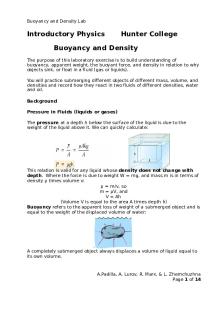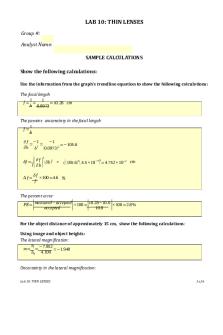Lab 10 PDF

| Title | Lab 10 |
|---|---|
| Author | Daniyal Hassan |
| Course | Fundamentals of Genetics |
| Institution | COMSATS University Islamabad |
| Pages | 14 |
| File Size | 1 MB |
| File Type | |
| Total Downloads | 38 |
| Total Views | 168 |
Summary
I have completed this course successfully and move on to next semester...
Description
Fundamentals of Genetics Lab 10
Name
Maouz Anwer, Zeeshan khan
Registration No
SP20-BSE-046
Class
Section A
Instructor`s name
Marya Mehmmod
Pattern of inheritance The main goal of this lab is to determine the number of genes involved for the traits and the mode of inheritance of each gene.
There are five questions in which we determines the number of genes involved for traits are given below Question 1; Head Top Problem statement; MendAliens, normal head top is dominant to Bart head top, in which the top of the head is jagged. Suppose a MendAlien homozygous for normal head shape is crossed with one homozygous for Bart head shape.
a. What are the genotypes of the two parents? 1%3B2 Explanation; If we use the symbol b for the mutant allele for Bart head top, and B for the allele for normal head top, the genotypes of the parents are: BB for normal head top, bb for Bart head top. b. the F1 generation 3
c. the F2 generation 3%3B1
Explanation;
d. the offspring of a cross of an F1 individual to a true-breeding normalhead-topped individual 2%3B1 Explanation;
e. the offspring of a cross of an F1 individual to a Bart-head-topped individual
1%3B3 Explanation;
Question 2; problem statement Refer to Problem 1, and assume again that normal head top is dominant to Bart head top. The following cross was done, producing the offspring shown below.
What are the genotypes of the parents? Explain your answer?
44%0D%0A Explanation; In the preceding question, and in all Mendelian crosses that involve a single pair of alleles controlling a trait, there are only three types of progeny ratios, depending on the types of parents involved: When one parent is homozygous dominant (AA x A-, AA x aa), the progeny ratio is all dominant to no recessive. (A- means the genotype can be AA or Aa.) That is: AA x AA gives all AA; AA x Aa gives 1/2 AA and 1/2 Aa; AA x aa gives all Aa. When both parents are heterozygous (Aa†x†Aa), as in a cross between two F1 offspring, the progeny ratio is 3 dominant to 1 recessive (3 A-:1 aa). When one parent is heterozygous and the other homozygous recessive (Aa†x aa), as in a testcross, the progeny ratio is 1 dominant to 1 recessive (1 Aa:1 aa).
Question 3; Problem Statement This problem involves MendAliens with one eye instead of the normal two and a purple skin color instead of the normal green. The following crosses were done:
a. What is the mechanism of inheritance for the one-eye (Cyclops) trait? Explain your answer The one-eye allele is recessive to the normal two-eyes allele. This is shown by the F1 MendAliens all having two eyes, indicating that two eyes is dominant to one eye, and the fact that there is an approximately 3:1 ratio of two-eyed : one-eyed MendAliens in the F2 generation (121:42)
b. What is the mechanism of inheritance for the purple-color trait? Explain your answer. The purple allele is recessive to the normal green allele. This is shown by the
F1 MendAliens all being green, indicating green color is dominant to purple color, and the fact that there is an approximately 3:1 ratio of green : purple MendAliens in the F2 generation (124:39).
c. Considering the two traits together, what can you say about how they are inherited? The F2 generation shows an approximately 9:3:3:1 ratio of phenotypes. This indicates that the genes for the two traits assort independently
d. Assign appropriate allele symbols, and diagram the cross through to the F2 generation. Using the convention of assigning a gene symbol based on the mutant phenotype, we can use the symbol c for the mutant allele for one eye (Cyclops) and C for the normal two-eyes allele, and p for the mutant purple allele and P for the normal green allele. The cross through to the F2 generation is: Explanation;
e. Give the appearances and their proportions in the offspring of a cross of an F1 individual to a one-eye, purple individual.
Question 3; problem statement The pointed-ear trait in MendAliens is caused by an X-linked recessive mutant allele. a. A female MendAlien, Marge, with no ears (the normal condition) and whose male parent had pointed ears pairs with a male MendAlien with no ears and whose male parent also had pointed ears. The pointed ears phenotype looks like this:
Using e for the pointed-ears allele and E for the normal no-ear allele, diagram the cross, and give the proportions of the phenotypes in the offspring that will have ears. (Give your answer separately for males and females.)
Since males always give their X chromosome to their female progeny, Marge must be heterozygous for the pointed ears allele, and be genotypically Ee. The male she pairs with received his X chromosome from his female parent, not his male parent. As he has no ears, he is EY (i.e., this signifies the E allele on the X chromosome and a Y chromosome)
Explanation;
b.
b. Assume, instead, that the female MendAlien, in part a, pairs with a male MendAlien with pointed ears as follows:
Diagram the cross, and give the proportion of the phenotypes in the offspring. (Give your answer separately for males and females.)
As already deduced, Marge must be heterozygous for the pointed-ears allele, and be genotypically Ee. The male has only one X chromosome, so he must be genotypically eY since he has pointed ears. Explanation;
Question 4; problem statement To investigate the genetics of the round-head trait, a cross between two roundheaded MendAliens was made with the following results:
a. What is the simplest explanation for the inheritance of these head shapes? The progeny are in an approximately 1 : 2 : 1 phenotypic ratio, which is the characteristic ratio expected for a cross between two heterozygotes if incomplete dominance is involved. Thus, the simplest explanation is that these head shapes involve incompletely dominant alleles, with one homozygote giving the normal head shape, the other homozygote giving a disk head, and the heterozygote giving a round head
b. Give the genotypes of the parents and the progeny.
c. What offspring would you expect from a cross between a MendAlien with a round head and a MendAlien with a disk head.
Question 5; problem statement In MendAliens, orange eyes (o) is recessive to the normal black eyes, and zebra striping (z) is recessive to no striping. Homozygous black-eyed, nonstriped MendAliens were crossed with orange-eyed, zebra-striped MendAliens. The F1 were testcrossed to orange-eyed, zebra-striped individuals to produce progeny as shown below.
What is the map distance between the genes for eye color and striping? First, we must realize that we are asked to find map distance because the genes are linked. We can see that the genes are linked because of the excess of parental phenotypes (72 + 69 = 141 parentals vs. 11 + 6 = 17 nonparental) in the progeny of the testcross. If the genes assorted independently, there would have been a 1:1:1:1 ratio of the four phenotypic classes.
Map distance is calculated from this formula: number of recombinants/total progeny x 100 = 17/158 x 100 = 10.8 map units. The map is:
For a review of the principles involved in gene mapping, go to the Recombinant frequency and Map distance section of the Vertical Eyes and Tooth trait analysis example....
Similar Free PDFs

Lab 10 - Lab 10
- 17 Pages

Lab 10 - Lab 10 Report
- 7 Pages

GEOG Lab 10 - lab 10
- 4 Pages

Lab 10 - PH111 LAB
- 2 Pages

Lab 10
- 14 Pages

Lab # 10
- 4 Pages

Lab 10
- 4 Pages

Lab 10
- 5 Pages

Orgo 2 Lab 10 - Lab Report 10
- 4 Pages

Post lab 10 - Post lab 10
- 3 Pages

Lab 10 - Lecture notes 10
- 3 Pages

Chem lab 10 - lab report
- 9 Pages

Phys lab 10 - Lab report
- 14 Pages

Practica lab 10
- 15 Pages

Lab 10 thin lenses
- 6 Pages

eScience Lab 10: Cells
- 6 Pages
Popular Institutions
- Tinajero National High School - Annex
- Politeknik Caltex Riau
- Yokohama City University
- SGT University
- University of Al-Qadisiyah
- Divine Word College of Vigan
- Techniek College Rotterdam
- Universidade de Santiago
- Universiti Teknologi MARA Cawangan Johor Kampus Pasir Gudang
- Poltekkes Kemenkes Yogyakarta
- Baguio City National High School
- Colegio san marcos
- preparatoria uno
- Centro de Bachillerato Tecnológico Industrial y de Servicios No. 107
- Dalian Maritime University
- Quang Trung Secondary School
- Colegio Tecnológico en Informática
- Corporación Regional de Educación Superior
- Grupo CEDVA
- Dar Al Uloom University
- Centro de Estudios Preuniversitarios de la Universidad Nacional de Ingeniería
- 上智大学
- Aakash International School, Nuna Majara
- San Felipe Neri Catholic School
- Kang Chiao International School - New Taipei City
- Misamis Occidental National High School
- Institución Educativa Escuela Normal Juan Ladrilleros
- Kolehiyo ng Pantukan
- Batanes State College
- Instituto Continental
- Sekolah Menengah Kejuruan Kesehatan Kaltara (Tarakan)
- Colegio de La Inmaculada Concepcion - Cebu